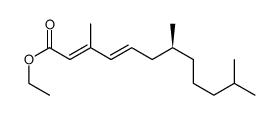s-hydroprene

s-hydroprene structure
|
Common Name | s-hydroprene | ||
|---|---|---|---|---|
| CAS Number | 65733-18-8 | Molecular Weight | 266.41900 | |
| Density | 0.886g/cm3 | Boiling Point | 339.2ºC at 760 mmHg | |
| Molecular Formula | C17H30O2 | Melting Point | N/A | |
| MSDS | USA | Flash Point | >100ºC | |
| Symbol |


GHS06, GHS09 |
Signal Word | Danger | |
|
The poultry red mite Dermanyssus gallinae (De Geer, 1778): current situation and future prospects for control.
Vet. Parasitol. 79(3) , 239-45, (1998) The current importance of Dermanyssus gallinae, mainly in egg layer, in Europe is pointed out. The limits of conventional control methods are underlined (development of mite resistance--future insecticide legislation and animal welfare legislation). Alternati... |
|
|
Effects of hydroprene on development and reproduction in the Oriental cockroach, Blatta orientalis.
Med. Vet. Entomol. 6(3) , 244-50, (1992) Nymphs of the Oriental cockroach Blatta orientalis were exposed during the penultimate and final instars to vinyl tiles treated with the juvenile hormone analogue hydroprene. Adults moulting from these nymphs exhibited deformities such as twisted wings in bot... |
|
|
Protein kinase C mediated phosphorylation blocks juvenile hormone action.
Mol. Cell. Endocrinol. 247(1-2) , 127-34, (2006) Juvenile hormones (JH) regulate a wide variety of developmental and physiological processes in insects. Although the biological actions of JH are well documented, the molecular mechanisms underlying JH action are poorly understood. We studied the molecular ba... |
|
|
Hydroprene prolongs developmental time and increases mortality in wandering-phase Indianmeal moth (Lepidoptera: Pyralidae) larvae.
J. Econ. Entomol. 99(4) , 1509-19, (2006) Wandering phase Indianmeal moth, Plodia interpunctella (Hübner), larvae were exposed to the label rate of hydroprene (1.9 x 10(-3) mg [AI] /cm2) sprayed on concreted petri dishes. Larvae were exposed for 1, 3, 6, 12, 18, 24, and 30 h and maintained at 16, 20,... |
|
|
Development of a HPLC/tandem-MS method for the analysis of the larvicides methoprene, hydroprene, and kinoprene at trace levels using Diels-Alder derivatization.
J. Agric. Food Chem. 53(9) , 3306-12, (2005) The invasion and subsequent spread of the mosquito-borne West Nile virus in the United States has resulted in increased use of methoprene. With the increased need for sensitive detection and monitoring of methoprene in the environment, an analytical LC/ESI-MS... |
|
|
Juvenile hormone regulation of male accessory gland activity in the red flour beetle, Tribolium castaneum.
Mech. Dev. 126(7) , 563-79, (2009) Male accessory gland proteins (Acps) act as key modulators of reproductive success in insects by influencing the female reproductive physiology and behavior. We used custom microarrays and identified 112 genes that were highly expressed in male accessory glan... |
|
|
Hydroprene prolongs developmental time and increases mortality of Indianmeal moth (Lepidoptera: Pyralidae) eggs.
J. Econ. Entomol. 99(3) , 1007-16, (2006) Eggs of the Indianmeal moth, Plodia interpunctella (Hübner), were exposed to the labeled rate of hydroprene (1.9 x 10(-3) mg [AI]/cm2) sprayed on concreted petri dishes. These eggs were exposed for 1, 3, 6, 12, and 18 h and until hatching (continuous exposure... |
|
|
Cloning of a beta1 tubulin cDNA from an insect endocrine gland: developmental and hormone-induced changes in mRNA expression.
Mol. Cell. Endocrinol. 141(1-2) , 141-51, (1998) A rapid increase in ecdysteroid hormone synthesis results when the insect prothoracic gland is stimulated with prothoracicotropic hormone (PTTH), a brain neuropeptide hormone. PTTH also stimulates the specific synthesis of several proteins, one of which is a ... |
|
|
Decreased JH biosynthesis is related to precocious metamorphosis in recessive trimolter (rt) mutants of the silkworm, Bombyx mori.
Arch. Insect Biochem. Physiol. 79(4-5) , 235-46, (2012) In recessive trimolter (rt) mutants of the silkworm, Bombyx mori, that have four larval instars rather than five larval instars of normal B. mori, a decrease after a small increase in the hemolymph ecdysteroid titer during the early stages of the last (fourth... |
|
|
Population growth of Dermatophagoides farinae Hughes (Acari: Epidermoptidae) suppressed by methoprene and hydroprene.
J. Med. Entomol. 30(3) , 531-6, (1993) Insect growth regulators are synthetic chemicals that mimic the function of hormones that occur naturally in arthropods. Two such insect growth regulators, methoprene and hydroprene, were tested to determine effects on growth of laboratory populations of the ... |